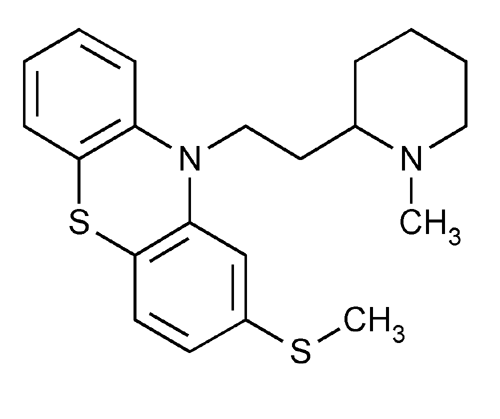Thioridazine
10H-Phenothiazine, 10-[2-(1-methyl-2-piperidinyl)ethyl]-2-(methylthio)-.
10-[2-(1-Methyl-2-piperidyl)ethyl]-2-(methylthio)phenothiazine
» Thioridazine contains not less than 99.0 percent and not more than 101.0 percent of C21H26N2S2, calculated on the dried basis.
Packaging and storage—
Preserve in well-closed, light-resistant containers.
USP Reference standards  11
11 —
—
USP Thioridazine RS.
USP Thioridazine RS.
note—Throughout the following procedures, protect test, or assay specimens, the Reference Standard, and solutions containing them, by conducting the procedures without delay, under subdued light, or using low-actinic glassware.
Identification, Infrared Absorption  197K
197K .
.
Loss on drying  731
731 —
Dry it in vacuum at 50
—
Dry it in vacuum at 50 for 4 hours: it loses not more than 0.5% of its weight.
for 4 hours: it loses not more than 0.5% of its weight.
Residue on ignition  281
281 :
not more than 0.1%.
:
not more than 0.1%.
Chromatographic purity—
[note—Conduct this procedure without delay, under subdued light.] Transfer 100 mg of Thioridazine to a 10-mL volumetric flask, add a mixture of methanol and ammonium hydroxide (49:1) to volume, and mix to obtain the Test solution. Using an accurately weighed quantity of USP Thioridazine RS, prepare two solutions in the same solvent system containing 50 µg per mL (Solution A, equivalent to 0.5%) and 20 µg per mL (Solution B, equivalent to 0.2%). Apply 5-µL portions of the Test solution and each of the two Standard solutions to a thin-layer chromatographic plate (see Chromatography  621
621 ) coated with a 0.25-mm layer of chromatographic silica gel mixture. Immediately develop the chromatogram in a solvent system consisting of a mixture of chloroform, isopropyl alcohol, and ammonium hydroxide (74:25:1) until the solvent front has moved about three-fourths of the length of the plate. Remove the plate from the developing chamber, mark the solvent front, allow the solvent to evaporate, and examine the plate under short-wavelength UV light: the chromatograms show principal spots at about the same RF value; no secondary spot, if present in the chromatogram from the Test solution, is more intense than the principal spot obtained from Solution A (0.5%); and the sum of the intensities of all secondary spots, if present in the chromatogram from the Test solution, is not greater than 0.5%.
) coated with a 0.25-mm layer of chromatographic silica gel mixture. Immediately develop the chromatogram in a solvent system consisting of a mixture of chloroform, isopropyl alcohol, and ammonium hydroxide (74:25:1) until the solvent front has moved about three-fourths of the length of the plate. Remove the plate from the developing chamber, mark the solvent front, allow the solvent to evaporate, and examine the plate under short-wavelength UV light: the chromatograms show principal spots at about the same RF value; no secondary spot, if present in the chromatogram from the Test solution, is more intense than the principal spot obtained from Solution A (0.5%); and the sum of the intensities of all secondary spots, if present in the chromatogram from the Test solution, is not greater than 0.5%.
Assay—
Dissolve about 300 mg of Thioridazine, accurately weighed, in 60 mL of glacial acetic acid, and titrate with 0.1 N perchloric acid VS, determining the endpoint potentiometrically. Perform a blank determination, and make any necessary correction. Each mL of 0.1 N perchloric acid is equivalent to 37.06 mg of C21H26N2S2.
Auxiliary Information—
Please check for your question in the FAQs before contacting USP.
Chromatographic Column—
| Topic/Question | Contact | Expert Committee |
| Monograph | Ravi Ravichandran, Ph.D.
Senior Scientist 1-301-816-8330 |
(MDPP05) Monograph Development-Psychiatrics and Psychoactives |
| Reference Standards | Lili Wang, Technical Services Scientist 1-301-816-8129 RSTech@usp.org |
USP32–NF27 Page 3727
Chromatographic columns text is not derived from, and not part of, USP 32 or NF 27.
